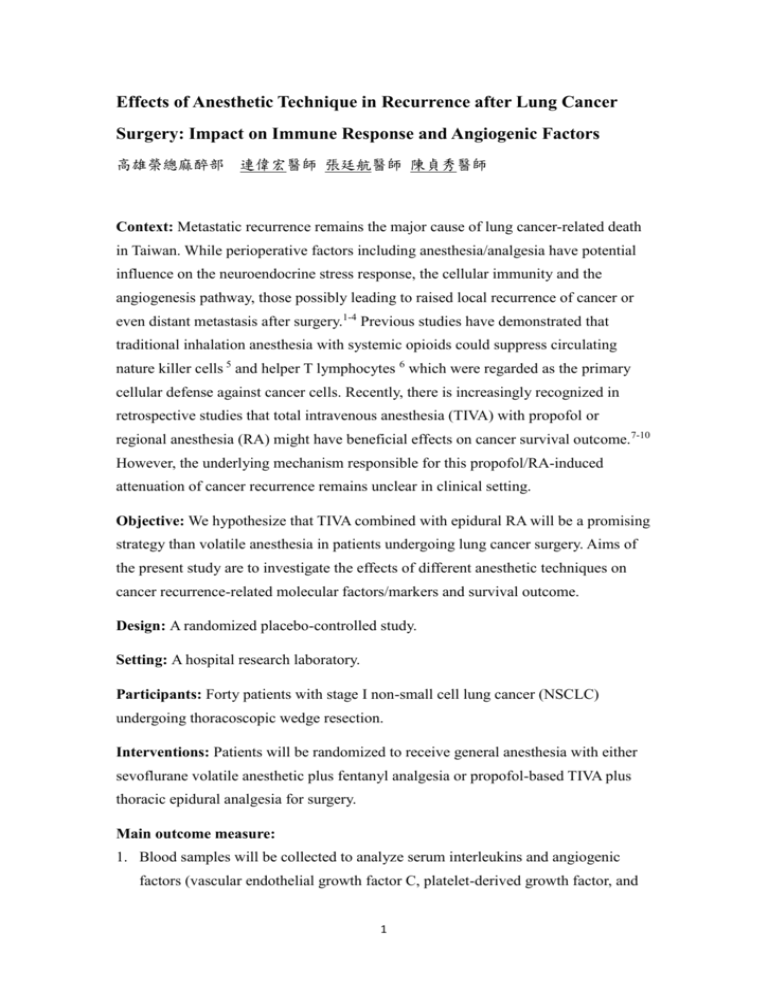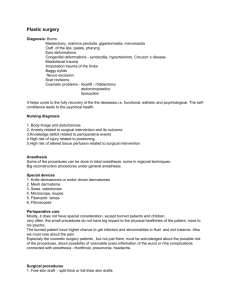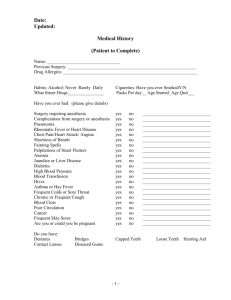Effects of Anesthetic Technique in Recurrence after
advertisement

Effects of Anesthetic Technique in Recurrence after Lung Cancer Surgery: Impact on Immune Response and Angiogenic Factors 高雄榮總麻醉部 連偉宏醫師 張廷航醫師 陳貞秀醫師 Context: Metastatic recurrence remains the major cause of lung cancer-related death in Taiwan. While perioperative factors including anesthesia/analgesia have potential influence on the neuroendocrine stress response, the cellular immunity and the angiogenesis pathway, those possibly leading to raised local recurrence of cancer or even distant metastasis after surgery.1-4 Previous studies have demonstrated that traditional inhalation anesthesia with systemic opioids could suppress circulating nature killer cells 5 and helper T lymphocytes 6 which were regarded as the primary cellular defense against cancer cells. Recently, there is increasingly recognized in retrospective studies that total intravenous anesthesia (TIVA) with propofol or regional anesthesia (RA) might have beneficial effects on cancer survival outcome.7-10 However, the underlying mechanism responsible for this propofol/RA-induced attenuation of cancer recurrence remains unclear in clinical setting. Objective: We hypothesize that TIVA combined with epidural RA will be a promising strategy than volatile anesthesia in patients undergoing lung cancer surgery. Aims of the present study are to investigate the effects of different anesthetic techniques on cancer recurrence-related molecular factors/markers and survival outcome. Design: A randomized placebo-controlled study. Setting: A hospital research laboratory. Participants: Forty patients with stage I non-small cell lung cancer (NSCLC) undergoing thoracoscopic wedge resection. Interventions: Patients will be randomized to receive general anesthesia with either sevoflurane volatile anesthetic plus fentanyl analgesia or propofol-based TIVA plus thoracic epidural analgesia for surgery. Main outcome measure: 1. Blood samples will be collected to analyze serum interleukins and angiogenic factors (vascular endothelial growth factor C, platelet-derived growth factor, and 1 fibroblast growth factor) before the induction of anesthesia, at the end of the surgery and 24 hrs after the surgery. 2. Lung tissue will be also sampled to determine the endothelial markers (CD340, CD31, D2-40/podophamin) and expression of VEGF and COX-2 by using immunohistochemistry and Western blot, respectively. 3. The ratio of T helper 1 and T helper 2 (Th1/Th2) will be measured by using flow cytometry before the induction of anesthesia, 1, 3 and 5 days after the surgery. 4. Short- or long-term cancer-free survival rate will be evaluated at 3, 6, 12, and 24 months. References: 1. Kurosawa S. Anesthesia in patients with cancer disorders. Curr Opin Anaesthesiol 2012; Mar 23. 2. Tavare AN, Perry NJ, Benzonana LL, Takata M, Ma D. Cancer recurrence after surgery: direct and indirect effects of anesthetic agents. Int J Cancer 2012;130(6):1237-50. 3. Snyder GL, Greenberg S. Effect of anaesthetic technique and other perioperative factors on cancer recurrence.Br J Anaesth 2010;105(2):106-15. 4. Gottschalk A, Sharma S, Ford J, Durieux ME, Tiouririne M. The role of the perioperative period in recurrence after cancer surgery. Anesth Analg 2010;110(6):1636-43. 5. Mitsuhata H, Shimizu R, Yokoyama MM. Suppressive effects of volatile anesthetics on cytokine release in human peripheral blood mononuclear cells. Int J Immunopharmacol 1995; 17: 529-34. 6. Inada T, Yamanouchi Y, Jomura S, Sakamoto S, Takahashi M, Kambara T, Shingu K. Effect of propofol and isoflurane anaesthesia on the immune response to surgery. Anaesthesia 2004;59(10):954-9. 7. Deegan CA, Murray D, Doran P, Ecimovic P, Moriarty DC, Buggy DJ. Effect of anaesthetic technique on oestrogen receptor-negative breast cancer cell function in vitro. Br J Anaesth 2009;103(5):685-90. 8. Looney M, Doran P, Buggy DJ. Effect of anesthetic technique on serum vascular endothelial growth factor C and transforming growth factor β in women undergoing anesthesia and surgery for breast cancer. Anesthesiology 2010;113(5):1118-25. 2 9. Exadaktylos AK, Buggy DJ, Moriarty DC, Mascha E, Sessler DI. Can anesthetic technique for primary breast cancer surgery affect recurrence or metastasis? Anesthesiology 2006;105:660-4. 10. Gupta A, Bjornsson A, Fredriksson M, Hallbook O, Eintrei C. Reduction in mortality after epidural anaesthesia and analgesia in patients undergoing rectal but not colonic cancer surgery: a retrospective analysis of data from 655 patients in Central Sweden. Br J Anaesth 2011;107: 164-70. 3 The SUMO deconjugating enzyme SENP1 switches IRF8 from a repressor to an activator and promotes macrophage activation 教研部 張聰賢 副研究員 Abstract Macrophages, when activated by interferong and toll like receptor signaling elicit innate immune responses. IRF8 is a transcription factor that facilitates macrophage activation and innate immunity. We show that in resting macrophages, IRF8 is conjugated to SUMO2/3 through the lysine residue 310. SUMO3-conjugated IRF8 failed to induce IL12p40 and other IRF8 target genes, consistent with SUMO mediated transcriptional repression reported for other transcription factors. SUMO3 conjugated IRF8 showed reduced mobility in live nuclei and bound poorly to the IL12p40 gene. However, macrophage activation caused a sharp reduction in the amount of SUMOylated IRF8. This reduction coincided with the induction of a deSUMOylating enzyme, SENP1 in activated macrophages. In transfection analysis, SENP1 removed SUMO3 from IRF8 and enhanced expression of IL12p40 and other target genes. Conversely, SENP1 knockdown repressed IRF8 target gene expression. In parallel with IRF8 deSUMOylation, macrophage activation led to the induction of proteins active in the SUMO pathway and caused a global shift in nuclear protein SUMOylation patterns. Together, the IRF8 SUMO conjugation/deconjugation switch is part of a larger transition in SUMO modifications that takes place upon macrophage activation, representing a mechanism to trigger innate immune responses. 4








